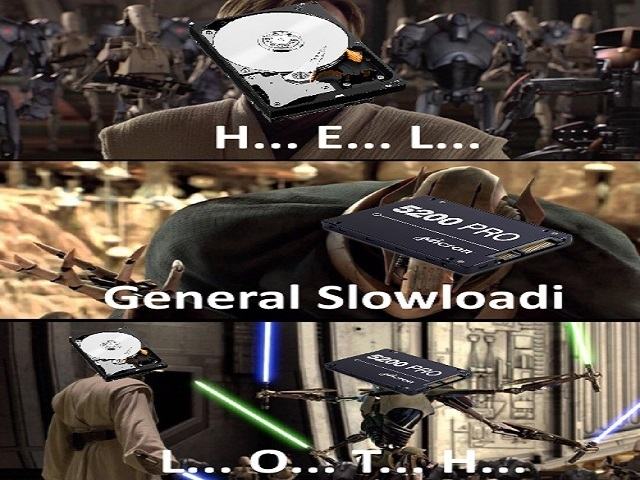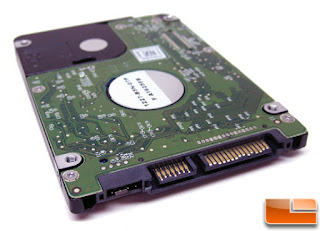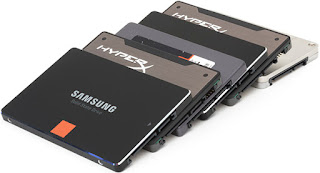
SSD Vs HDD: who would win?
This is among the most asked questions that people present to
their product vendors when buying a storage device and as such one would expect to find an easy and clear cut
answer for it. However, the truth is these two storage devices have their own ups and downs that have managed to
keep them both in the market for this long. Some
SSDs
,
not all, even connect using the SATA port and
cables
which make it even more difficult to discern between the two, however the two storage solutions do differ in the
way they store, write and read information. That being said, let’s start with a brief history of the Hard Disk
Drive and Solid State Drive and see how those two compare to one another.
Hard Disk Drives
(Image above shows the internals of a 2.5 inch SATA HDD)
Hard disk drives, HDDs for short, are data storage devices that use magnetic media to store
and retrieve digital information using one or more rigid rapidly rotating disks (platters) coated with magnetic
material. The platters are paired with magnetic heads, usually arranged on a moving actuator arm, which read and
write data to the platter surfaces – which in layman’s terms means that there are mechanically moving parts
within an HDD that write and read data (more on this later). Hard disks were first introduced into the
market during 1956 by IBM in order to serve as the storage unit for a real time transaction processing computer
having a size of two refrigerators and storage capacity of 3.75 megabytes. Having read that, you might have
gleaned that we have come a long way as far as storage capacity is concerned, but if you didn’t look at the
statistics given below.
|
Parameter
|
Started
with (1956)
|
Developed
to (2017)
|
Improvement
|
|
Capacity
(formatted) |
3.75 megabytes
|
12 terabytes
|
3.2-million-to-one
|
|
Physical
volume
|
56,000-to-one
|
||
|
Weight
|
15,000-to-one
|
||
|
Average
access time
|
approx.
600 milliseconds
|
2.5 ms
to 10 ms
|
about
200-to-one |
|
Price
|
US$9,200
per megabyte (1961)
|
US$0.032
per gigabyte by 2015
|
300-million-to-one
|
|
Data
density
|
1.3
terabits per square inch in 2015
|
650-million-to-one
|
How do HDDs work?
All HDDs old and new are essentially the same; there is a
rotating disk which is coated with a magnetic material and an arm, also known as the actuator arm, hovers above
it reading and writing information onto the hard disk. Since the rotating disks (platters) are circular in shape
the actuator arm would have to move from place to place to read different parts of the platter (those that are
near to the center and those that aren’t). This movement is among the key features that limit how fast HDDs can
be and one that probably cannot be solved above a certain point. Generally, to make hard disk drives perform
faster a manufacturer would have to make the platters inside rotate at a faster rate, at the same time giving
the actuator arm the spot on the platter it needs to write on or read off faster. The HDD with the highest
rotational speed currently available in the consumer market is one with 10,000 RPM. The fastest is a drive with
15,000 RPM, but it isn’t available to consumers. Most of you might be familiar with 5400 RPM drives and 7200 RPM
drives. The more rotational speed a HDD has however means the more heat they dissipate.
What makes an HDD
special?
US$0.032 per gigabyte – HDDs are the cheapest storage devices
out there to store large files.
12 terabytes – HDDs are amongst the biggest storage devices
present commercially for public use.
Solid
State Drives
(Top and bottom views of a 2.5-inch 100 GB SATA 3.0 (6 Gbit/s)
model of the Intel DC S3700 series)
Are solid-state storage devices that use integrated circuit
assemblies as memory to store data. New I/O interfaces like SATA Express and M.2 have been designed to address
specific requirements of the SSD technology – so it is possible to switch from an HDD to SDD and Vice Versa is
the SDD. SDD can be attached to different ports with the mainstream choice being the SATA port but also coming
with the mSATA (mPCIe port). These drives, unlike their rivals, are completely digitalized meaning there are no
moving parts. Moreover, since an SSD is completely digital, data can be read/written faster than an HDD.
What makes an SSD special?
It is fast – In consumer products the maximum transfer rate
typically ranges from about 200 MB/s to 2500 MB/s, depending on the disk. Enterprise market offers devices with
multi-gigabyte per second throughput.
Read performance – Read performance does not change based on
where data is stored on an SSD.
Noise – no moving parts simply means SSDs are silent.
A faster Random access time – under 0.1 ms.
More storage space with 60 TB max – but extremely expensive and
unlikely to be present in every household.
Little Impact of file system fragmentation on speed – There is
limited benefit to reading data sequentially (beyond typical FS block sizes, say 4 KB), making fragmentation
negligible for SSDs.
What makes SSDs bad for business?
SSDs are degradable – Although SSDs have no moving parts to fail
mechanically. Unlike mechanical hard drives, current SSD technology suffers from a performance degradation
phenomenon called write amplification, where the NAND cells show a measurable drop in performance, and will
continue degrading throughout the life of the SSD. Each block of a flash-based SSD can only be erased (and
therefore written) a limited number of times before it fails. The controllers manage this limitation so that
drives can last for many years under normal use. SSDs based on DRAM do not have a limited number of writes.
However, the failure of a controller can make a SSD unusable. Reliability varies significantly across different
SSD manufacturers and models with return rates reaching 40% for specific drives. Many SSDs critically fail on
power outages; a December 2013 survey of many SSDs found that only some of them are able to survive multiple
power outages – but this won’t be a problem when the SSD is plugged into your Laptop.
Files are less secure on an SSD – NAND flash memory cannot be
overwritten, but has to be rewritten to previously erased blocks. If a software encryption program encrypts data
already on the SSD, the overwritten data is still unsecured, unencrypted, and accessible.
My advice to you
This decision to be truthful is Purely about what you want from
your PC and is rather easy to make.
If you are going for a cheap storage device, then the HDD is a
clear choice.
If you are going for lightning fast data transmission, then the
SDD is your best fit.
This is Yared with ICT, signing off.


